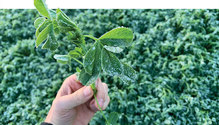Close
POTASSIUM (K) can make a case for the “Don’t get no respect” award among the fertilizer nutrients
Concerns about brunswickgrass in bahiagrass pastures and fields began about 15 years ago in Levi County, Fla
According to data that was recently released by the National Agricultural Statistics Service (NASS), there are roughly 1.8 million dairy cows in California
With tight margins in the dairy industry, we sometimes look to reduce feed costs as a method to improve margins
Most forages produced for horses are not analyzed for nutrients, and it’s understandable
A season with weather, tariffs, and constantly changing markets, the need to become more efficient and diversified is key
Alfalfa may be known as the “Queen of Forages,” but there’s no disputing the fact that grasses are grown more widely across the U.S. and provide the backbone of the greater forage industry.Grass
While alfalfa fields in the South are being cut, some for a second time, those in the North are just waking from winter slumber . . . or at least we hope they are
Herbicide-tolerant crops have been widely adopted across production agriculture. Over 90% of canola, sugar beet, soybean, cotton, and corn crops in the U.S. are herbicide tolerant
There are many methods used by growers to determine when and how much to irrigate forages. Some decide to turn the water on after handling a shovel-full of soil
The next time you drop a round bale into the ring feeder, think about the investment that you’ve made in that bale
Whether you are in the business of growing and selling forages or feeding cattle, correctly assigning the economic value of forages can impact profitability
Just like managing dairy cows, there is a lot more to putting water on crops than it looks
What makes alfalfa such an interesting crop to study and try to understand is what also makes it so frustrating.I quit trying to predict alfalfa winterkill years ago
BALEAGE, or making silage in bales of wilted forage that are wrapped in plastic to create an anaerobic environment, allows for the more timely harvest of forage crops
HE San Joaquin Valley (SJV) of California is home to about 1.7 million lactating dairy cows, andthat number of cows needs a lot of for- age
Whether you are in the business of growing and selling forages or feeding cattle, correctly assigning the economic value of forages can impact profitability
Craig Sheaffer has worked with alfalfa his entire academic career. The University of Minnesota researcher can reel off a bevy of advantages that alfalfa adds to a farm’s cropping and feeding systems
Photo: Robert Webster There are lots of things in life that rarely occur. The Chicago Cubs, for example, take home a World Series title about once per century. The Kansas City Chiefs are particip
Gary Bates is a self-proclaimed world’s expert on forage establishment failures. “Nobody has made more mistakes than me,” he said with tongue in cheek.The director of the University of
..
Visit our partner publications:
Hoard's Dairyman | Journal of Nutrient Management



















